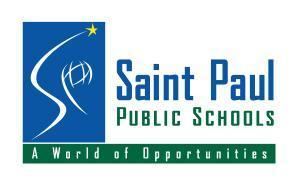Type Public Established 1856 Area 145.5 km² Founded 1856 Staff 5376 | Grades K-12 Superintendent Dr. John Thein Number of students 39,086 Motto A World of Opportunities | |
 | ||
Budget $629.1 million (2007-2008) Profiles | ||
Saint paul public schools back to school 2013
Saint Paul Public Schools (SPPS) is a school district that covers all of the city of Saint Paul, Minnesota.
Contents
- Saint paul public schools back to school 2013
- Demographics
- Governing body
- Middle schools 6 8
- High schools 9 12
- LEAP International Academy
- iPad Program
- References
Saint Paul supports a robust network of publicly funded primary and secondary schools. Saint Paul Public Schools is the state's largest school district and serves approximately 38,380 students. The district runs 67 different schools including 48 elementary schools, 8 middle schools, 7 high schools, 3 alternative schools and one special education school. The district also employs over 6,500 teachers and staff. The entire school district also participates in the University of Minnesota's College in the Schools program.
The school district also oversees community education programs for pre-K and adult learners, including Early Childhood Family Education, GED Diploma, language programs and various learning opportunities for community members of all ages.
In 1993, St. Paul became the first city in the U.S. to sponsor and open a charter school, now found in most states across the nation. Saint Paul is currently home to 21 charter schools.
In 2006, the St. Paul Public Schools celebrated its 150th anniversary. Notable graduates of St. Paul Public Schools include former U.S. Supreme Court justices Harry Blackmun and Warren Burger, civil rights leader Roy Wilkins, creator of the Peanuts cartoon strip Charles M. Schulz, and many others from various professions and among notable achievements.
Demographics
The district has students from families speaking 70 different languages, although only 4 languages are used for most school communication. Those languages are English, Spanish, Hmong and Somali. 73.91% of students are students of color. 69% of the district's students qualify for free or reduced lunch, 17% of students are considered Special Education and 40% of students are ELL (English Language Learners). The school district currently receives $22 million a year in desegregation funding from the state. However, because of two United States Supreme Court cases, schools are no longer allowed to assign students to schools based on race.
As of 2001, the district had 46,000 students. About one third of them were Hmong. At the time, about 13,000 of the Hmong students received English as a second language (ESL) services. In 2002, of all of the American school districts, St. Paul had the largest Hmong student population.
Governing body
The governing body of the school district is the seven-member Board of Education. The Board of Education then appoints a Superintendent who is responsible for the general supervision of the school district.
Board of Education is elected during Saint Paul's general municipal elections. Board members are elected every two years in odd-numbered years and serve staggered four-year terms. The school board elections are technically nonpartisan, however most candidates seek and advertise party endorsements.
The current Superintendent is John Thein. The current Board of Education members are:
Middle schools (6-8)
High schools (9-12)
LEAP - International Academy
In Fall of 1994, Saint Paul Public Schools started the Limited English Achievement Program (LEAP) as a school completely dedicated to English language learners (ELL) aged 16 to 24 years. In 2005, the school's name was changed to "International Academy - LEAP" to reflect a more direct meaning for the school. These are students whose needs often do not match the offerings provided in traditional high school.
iPad Program
Two roll outs of the iPads were scheduled for the 2015-2016 school year, with the target of supplying every student in the district with iPads for use in the classroom. The vision is to use Specialized Learning along with use of the iPad to engage and track student's progress throughout the day/year.
A roll out did take place in the 2014-2015 school year, but not all schools received these iPad. The majority was pushed to the following year.
